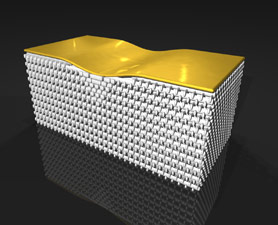Scientists at the Karlsruhe Institute of Technology in Germany and Imperial College London have brought us one step closer to the invisibility cloaks made famous by the Harry Potter stories. Scientists from the two institutions have made an object disappear, according to a study published Thursday in the journal Science.

The cloak they developed was made using photonic crystals with a structure resembling piles of wood, to conceal a small bump on a gold surface, they wrote in Science.
“It’s kind of like hiding a small object underneath a carpet — except this time the carpet also disappears,” they said.
“We put an object under a microscopic structure, a little like a reflective carpet,” said Nicholas Stenger, one of the researchers who worked on the project.
“When we looked at it through a lens and did spectroscopy, no matter what angle we looked at the object from, we saw nothing. The bump became invisible,” said Stenger.
The “cloak” they used to make the microscopic bump disappear was composed of special lenses that work by bending light waves to suppress light as it scattered from the bump, the study says.
The invisibility cloak was minute, measuring 100 microns by 30 microns — one micron being one-thousandth of a millimeter — and the bump it hid was 10 times smaller, said Stenger.
The researchers are working now to recreate the disappearing bump but on a larger scale, but Stenger said Harry Potter’s invisibility cloak would not be hanging in would-be wizards’ wardrobes in the near future.
“Theoretically, it would be possible to do this on a large scale but technically, it’s totally impossible with the knowledge we have now,” he said.



